A Dialogue on Walls with Jay Isenberg

[Image: "Today they shoot your son, tomorrow they shoot mine." -Uri Na’amati, Israeli father of Israeli protestor Gil Na’amati from “Barrier”, Isabel Kershner, p.126, Palgrave Macmillan 2005 / A relinquary for Dialogue on the Wall / Photo by Bill Kelley.]
A couple of months ago I stumbled across the project Dialogue on the Wall by architect Jay Isenberg out of Minneapolis. He installed his own portion of the Israeli Security Wall in the Form + Content gallery using the barrier as a historic narrator of the Israeli/Arab conflict, and to reflect cultures and personal stories on all sides of the border. What I found most intriguing was the notion of the wall serving as a kind of healing space for its own scarring and spiritual wounding.
Soon after, Jay and I made contact and traded this short meditation on walls over email. To my pleasant surprise, I found out this current project is actually part of a sequence that Jay is working on to explore this theme of the wall serving as a bi-cultural mirror for conflict suture.
[Bryan Finoki] What are the more intimate connections the show was making between the Wailing Wall and the Separation Wall?
[Jay Isenberg] "Dialogue on the Wall" is our second work based on the concrete portion of the Barrier between Israel and Palestine. You don't have to point out that one's choice of words when referring to this is laden with meaning and indicates the speaker/writer's point of view as well as one's entry point into this conflict. In any case, the first project was called Two Walls - An Architecture of Conflict and Reconciliation that was a totally virtual installation co-created by Ron Haselius, an architecture trained digital modeler whom I've worked with in the past. Images from this project can be seen at www.twowalls.blogspot.com. This project sprang from a sketch I made of these two iconic Walls, the Western (Wailing Wall) and the Separation Wall colliding. What kind of space and what kind of commentary would this trigger if these two Walls, so opposite in history and meaning collided? The result was this virtual installation with its large scale spaces of opposite sides, zone of collision, and place of reconciliation and contemplation. It was accompanied by two presentations at St Cloud State University under the auspices of the Rabbi Joseph Edelheit, head of the Jewish Studies program, which has its own interesting and poignant history.
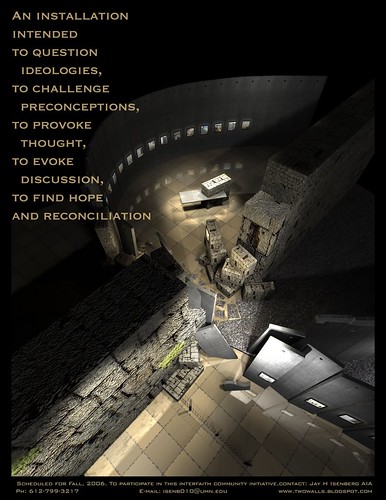
[Image: From Two Walls - An Architecture of Conflict and Reconciliation by Jay Isenberg.]
After these presentations the project was put to bed for a year and didn't raise itself again until we joined the collective, Form + Content Gallery and now had an opportunity to take some of these ideas and transpose them into a real installation, one designed specifically for a small gallery and on a limited budget. What to consolidate with so many options and how to execute them was daunting. I knew we had to build a "Wall" in the gallery, that we were going to project text and images on it, that there was going to be other art forms interacting and that it was to collide with the Western Wall. Funny thing happened on the way to Dialogue, the Western Wall disappeared totally from the project, it turned out that the visceral power of the Wall we built was plenty to serve as this backdrop for engagement and conversation. And so the "intimate connections" you asked about had to emerge from conversation or self reflection and never really became an element of overt significance. I might also add that there were no references to nor images of the Holocaust. As significant as it is to understanding one perspective, I purposely wanted this to come from the viewers and not imposed upon them.

How did you go about designing this project, from the construction of the wall to the selection of objects embedded into it? How did you gather this material?
To build on the last question and answer, the intimate connections came from designing and viewing the Reliquaries. This idea was totally my wife's, Lynda Monick-Isenberg who is an artist, thinker and teacher and total collaborator on this project. Many of the ideas and their development we owe to the time we spent on nightly walks with our two border terriers. Her history and understanding of ancient reliquaries as vessels for sacred objects (bones) struck us like lightning as the perfect expression of the intimate connections shared by both traditions, from burial practices, homage to the land and olive trees to the violence and horror of terror upon all, especially children.
So, we found these objects (plenty of dumpster diving), encased them in acrylic vitrines, searched for and found interpretive words of poets and writers to overlay upon them and connect the visual with the written. We did not cite the writers on the reliquaries in order to minimize preconceptions of the viewer. These emerged from the Wall within a narrow space covered by a chain link and steel stud dropped ceiling. Here is where the heart of the exhibit and the issues of the conflict spoke with intimacy if one listened.
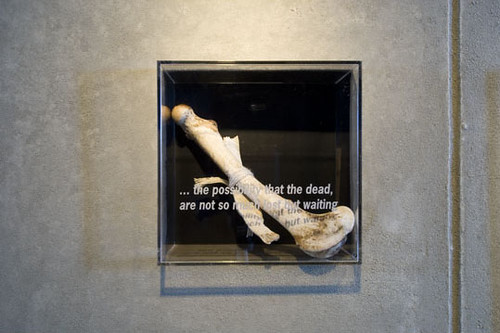
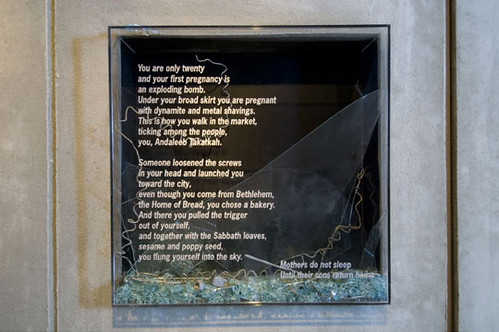
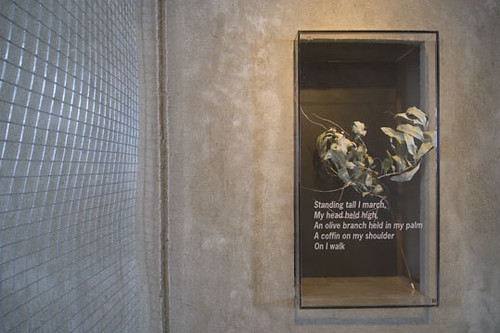
The construction of the Wall, do I have to tell? Ten foot high by four feet wide steel stud panels faced in half inch thick homasote and veneered by artist Jeremy Clark with his "special sauce"; a vinyl plaster cement mixture sprayed and troweled on in several late Thursday night sessions. Each panel weighed about 70 pounds or more and had to be hand carried into the gallery tilted and locked together. This however was the easy part compared to working with cyclone fencing as ceiling material in a 30 foot long trapezoidal shape!
Did you ever consider bringing people from both sides together in the making of this project? Representing the conflict together to share a hand in the direct making of this project strikes me as having a powerful mutual healing quality to it. Did you involve folks this way to exchange dialogue through the process?
This is a really interesting question because it gets at the heart of a number of intentions and revelations. One of the original hopes was exactly what you mentioned; to invite artists from different mediums and cultural/political perspectives to "interact" with the Wall through their chosen art form whether it be performance art, music, dance, visual and digital arts, photography etc.
Since we are members of the gallery collective we chose a very short time frame in which to design, build and organize the installation. You know architects, the longer the horizon the more time to work on something else until deadline! So we began to ask for and contact recommended artists about 6 months before the scheduled opening, met with several that were interested to various degrees, and brought study models of the installation's design as it was progressing.
What we discovered through this initial process was that artists and architects have a wholly different idea of collaboration and how the design process works for them. What collaboration is to architects as a naturally and very iterative, changing yet inclusive process to the very end does not seem to be how others saw it or needed it. Some just wanted a theme and a space, others wanted to interpret issues form their own story that didn't specifically relate to the Israeli Palestinian conflict. This might have been appropriate and desired in another project, but not for this one. Issues of control, both spatial and artistic became challenging, and we soon realized that this was our project (my wife and I) and that others were not really able to engage as we imagined. Now this might have much to do with our own vision of this and its content, as well as the small size of the gallery, but in the end, there were no other artists that contributed pieces or artistic interactions. We did however have a beautiful evening with a Jewish vocalist and an Egyptian oudist playing two sets from atop the mezzanine to a packed gallery crowd below, the session was called "Beyond the Wall...."

So your instinct on the collaborative potential as healing is spot on. I think what is needed in any future efforts is for the creative and organizing artists representing the various perspectives to come together at the beginning of any project before it has taken shape, form and its own dynamic. If one party owns it more than another it can have the same difficulties as the political manifestations we see in the conflict itself. It would be quite interesting to be a part of such a process and not one I imagine would go well, especially with a diversity of passion present. It would take a Dennis Ross to mediate the process.
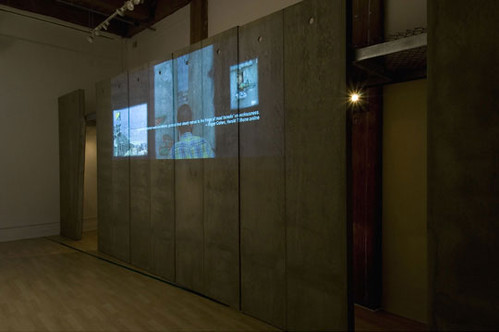
Tell me how the wall is a narrator – of power, political negotiation, of history, as a canvas for resistance? How are walls archives of political contest, or bi-nationalism? Security Walls aren't always simply imposed as we might think by one nation next to another, but can be the result of more formal and informal conflict and collaboration – did the show address this duality?
The wall itself is the narrator and the metaphor, the protector and prison, the symbol and reality of a colossal failure to overcome the history and tragedy. It is depressing beyond all rationality, but cannot be denied. The story of its being is the story of two complex and competing narratives, and depending on your "stake" in the situation will determine what side you come down on, if you can come down from its perch. I think I could have built just this wall and nothing else and it would have been a catalyst for dialogue. There is text from a poem I wrote that runs across the sheet-rock wall opposite the Wall, one stanza of four reads,
Stories of the Wall
Haunted
Told to the Deaf
Written on the Concrete Canvas @
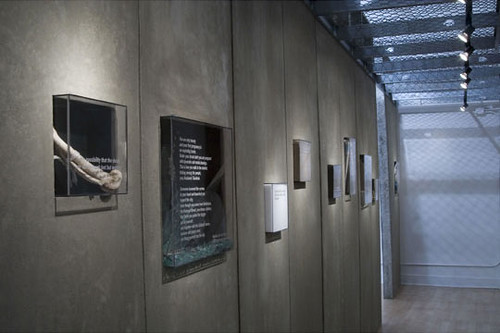
I mentioned earlier the different entry points people bring to a discussion or lack thereof on this conflict. It's important to understand mine, since it is critical to intentions. My interest in architecture is at the intersection of its delivery process, ethics, law, psychology and theater, and as such I also practice as a mediator and arbitrator of design and construction disputes. My natural viewpoint is as a neutral and from there I navigate through issues. The complexity of this conflict is astounding and this installation is really a mediation through our own conflicting attitudes and opinions. While I can't and won't divorce myself from my jewishness and a commitment to a secure jewish state and my understanding of that as historically just, I cannot accept many aspects of Israeli policy and how it has affected the Palestinians in their pursuit and ability to form a viable and just state of their own. The irony of Israel building a Wall around itself is not lost on me. The installation provided the backdrop to present contradictory evidence and ideas and to think about one's own viewpoint, and if your eyes were opened at all, asked you to think about the other. It was ironic that those that came "certain" saw bias against their position whether they were pro this and against that or pro that and against this. I thought this was telling. Those that came with little knowledge or were themselves uncertain came away with a deeper sense of what the issues were as how deep they affect the inhabitants. To be sure, neutrality itself was looked at critically.
What was the most surprising thing to come out of the show, the most unexpected element, reaction, or consequence?
There was a point during one of the conversations we had with "youth" that was facilitated by Steve Busa, artistic director of the Red Eye Theater here in Minneapolis, who works in the public schools with students using a certain protocol for group dialogues. At the end everyone held various text which I had compiled and passed out randomly and they were asked to read aloud the text they held when they felt the need. It began slowly with one person reading their quotes and others listened respectfully until finished, then the next might read a competing quote, but after a few of these were read in this manner, someone interrupted another with their quotes, then another began and soon several voices were reading their contradictory quotes at the same time with rising volumes and in no time at all a cacophony of voices filled the gallery, all reading their text like it was their own words, some believing them, others choosing to because of the mood, and others fully opposed to the position or emotion they voiced. Some sat silent, unable or unwilling to read the voice they had been handed. I stood alone behind the Wall and listened as my own inner voice, the one that had been struggling for months inside me was played back to me by the participants in this magical exercise of empathy, a mirror of our mediation through this conflict. Perhaps this was the most unexpected situation that happened.
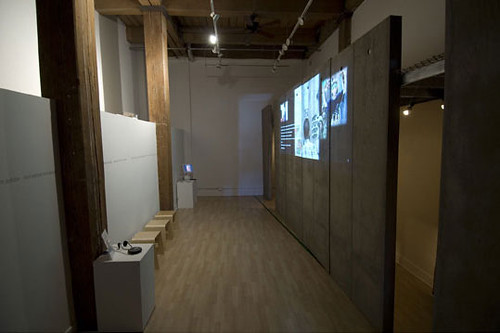
What do you think it will take to remove the wall in Israel/Palestine? What steps should be taken? How do you even begin that process?
Let me go back to the issue of entry point into this conflict. What you are doing with Subtopia is impressive and important, because it brings to our attention the multiple ways in which architecture, architects, planners and others not generally thought of contribute knowingly or unknowingly to conditions of injustice, political and military control and social decay through border treatments, walls, and other interventions. For this I am in awe of your efforts.
However, when it comes to Israel Palestine and maybe for other conflicts and those deeply connected to them, the conversation likely will go nowhere without understanding and accepting the deep seated historical and generational roots of each side. To only talk of Walls, checkpoints, border control, apartheid parallels and oppression of the Palestinians without the context of the psycho-cultural "jewish" issues of security, historical assimilation and diaspora, the particularity and marginalized self image struggling against itself now as a military power is to miss this internal conflict as entry point for many. If the struggle is justice and international law versus security, which would you pick? Not easy and a moving target as well. While the Holocaust was not overtly part of our installation, to not understand its core position, at least for diaspora Jews in thinking why the response from Israelis is so harsh and as many say not at all proportional is to miss something critical. To think that Jews in a position of power and control over their own destiny on what they consider to be their historical land for the first time in thousands of years would relinquish willingly this authority to anyone is unthinkable to me. To talk of a one state solution is preposterous in light of the jewish experience under other's authority, as I can't imagine them trusting the "democracy" of a one state condition, too many pograms and other memories lurking in the subconscious. But to say this might not change in ten or twenty years because of global conditions and potential catastrophes, who knows?
I suspect a Palestinian would give an equally passionate case for their cause and I would empathize and accept that narrative. I guess I am making a case for providing some of this imbedded apriori understanding for readers, because to me it isn't as simple as oppressor and oppressed manifested in concrete walls.
First, I appreciate the compliment, and respect your position. It's the very nature of walls to obliterate perspective - and what else can both sides do but strive to listen, accept, and try to help heal one another in anyway they can and move forward? I realize though that may sound hopelessly utopic at this point.
And I also agree with you that my critique can often times lack critical context and fall into its own trap of producing a sort of superficial image-based narrative of conflict space.
I think at this point all I can genuinely do is try to facilitate connections and dialogue between people, with people, and try to be more aware of how my own politics might sabotage that.
In some ways Subtopia has caused me to proceed with both a more open mind but also a counter re-enforced closed mind. It's easy to get fatally negativistic about all this stuff - but I'm trying to use the blog as a learning experience and to keep myself receptive to new ways of seeing and understanding how political conflicts transmit power through space.
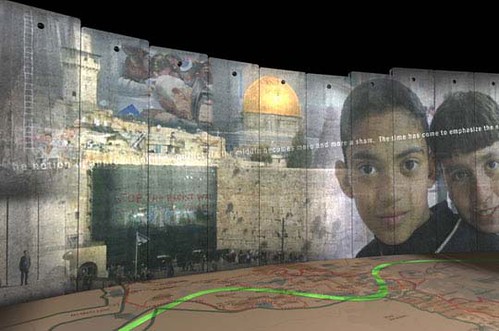
On that note, how do you think architects can help to subvert these border spaces, what should – if any – be their role in acknowledging and intersecting with these contexts? That is, while architects often do work that is more complicit with the creation of borders and spaces of division, how can they get involved in a way that can undo the border, or, de-architect it in a way towards more ideal alternatives?
I don't think there are many who approach the profession in this manner, and if they do enter the field of politics and conflict, it is in the areas of sustainability and sustainable communities, performance of buildings, homelessness and affordable housing and other "design can make a difference and improve our social order" manifestations. Typical avenues for idealism and how the schools organize and funnel this safely through design studio with design/build shelter projects, housing prototype studies etc.
Too true! And well said. Green, sustainable, shelter, they can be such self-congratulatory buzzwords!
Weizman and others like yourself have surely opened up our eyes, but around here it's pretty much business as usual except a few who are engaged with these matters. I would say that only a few of the many architects I know came to the installation and many were friends who might only have come because it was ours. Perhaps, if the project was installed in the architecture school, or it had not been so specific to the Israeli Palestinian conflict, there might have been more engagement by the architectural community. Those that did come though surely appreciated the design and construction components, everyone loved touching the Wall. But I do agree that this type of work (installation) would be very challenging for students and take them into areas at the intersection of design and politics that would be fruitful, and this is the type of studio I would be interested in.
It's unfortunate the politics of architecture comes with its own stigma that we would need to consider abstracting it into something like a harmless generic but form-dazzling wall or something to get architects to ponder this basic currency of space.
I'm curious about people touching the wall. What was the sensation, the tactile intrigue? What was that all about? I love the idea that something as mundanely and humanly preventive as a wall becomes something totally sensual in some way. Are you telling me you rendered a full-on mystical experience in the gallery?
This was a really nice surprise because we loved this faux "Wall" as architects and artists, just looking at it and touching it, knowing that it was a veneer over homasote but looking and feeling like concrete with heft and visceral heaviness, yet, like you said sensuous in that paradoxical way. And then seeing others walk in and touch the wall and you could see them pondering how we got this in here and even how we got this "over" here, like it was a section of the Wall itself. Layer that with the images and symbols of conflict and it turned into a curious mix.
Sorry I didn't get to check it out. But I have a feeling something akin will resurface at some point – so what next?
You're right, this is not the end. I am designing an entry for the Just Jerusalem2050 competition you also posted about and while it isn't directly about the Wall, it does occur in the "Seam". In your post of March 14, 2007, "The Green Line", you stated, "To go with it, I wish there were a series of street signs or some other project that would build upon this one, guiding folks along the actual path of the Green Line as it was intended...a walk of shame tour ..." etc. By now you must know I don't see the Wall and the Green Line with the same characterization as you, but I do see them as outlining a space of the uninhabited that will become the site for this project. It won't be marked with shame but with humility and will try to recognize and teach through markers and commemoration the complexity of the issues of this conflict so posterity will be a witness to who we are as human beings in all our glory and madness. It will be about pilgrimage and hope.
This sounds excellent – I can't wait. Pilgrimages of hope – who doesn't want to go on one of those?
[All images of the installation and reliquaries were taken by photographer Bill Kelley. You can also download the Project Brochure as a PDF here on the Form and Content Gallery website that has the citations for the poetry on the Reliquaries.]







3 Comments:
I was a participating photographer in the Dialogue on the Wall exhibit. (Most of the images in the collage in the bottom-most photo are mine; others were projected onto the wall and used as an accompanying slideshow.) Although our political views differed, Jay's determination to deal with this difficult issue impressed me, as did the thought-provoking and moving installation he and Lynda created. I remain grateful Jay asked me to take part.
Despite the installation's overall success, one display-related event fell victim to some of the complexities raised by this contentious topic. My own sense of what happened at the exhibit's accompanying panel discussion is described in two blog postings. The first is a short summary, the second a more critical discussion. As noted in the interview, people brought to the installation different assumptions and priorities. My blog postings reflect my own, as do my photos of Israel and Palestine.
Dennis,
thanks for the scoop. those are interesting write-ups. much of what you say resonates with me: about a solution not relying on a forfeiture of past, but decidedly on achieving justice. and your criticism of the traditional bi-national dialogue, seemingly such an exhausted model now.
and your own insistence on trying to wrestle with the difficulties of the topic and the event itself in some of the ways you suggested should be noted as well.
i'm curious, how might we explore new formats for discussion? that space alone needs to be completely just within itself if it is to have any merit, so what are the kinds of diplomatic events -- and just mediation spaces -- we should be modeling for cooperation? what does the new negotiating table itself need to look like?
thanks again for your input, super appreciate it.
b
Bryan, I responded to this earlier but don't see it here. So briefly: My response got long enough to turn into a blog entry of my own. I hope you'll look at it and we can continue the conversation.
Dennis
Post a Comment
<< Home